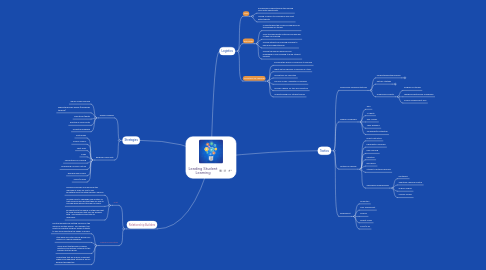
1. Relationship Builders
1.1. Trust
1.1.1. Discuss anomalies and removing the unknown in order for you to see something from the other person's opinion.
1.1.2. Provide room to challenge one another so that everyone will feel that they are able to provide ideas without the fear of failure.
1.1.3. Be sensitive to the needs of others and get to know the person that you are working with. Ask questions and listen to responses.
1.2. Making Connections
1.2.1. Eliciting empathy by putting yourself in the shoes of another person. For example, the Roots of Empathy program allows students to see and understand the needs of a baby.
1.2.2. Step back and listen before giving your opinion or offering feedback.
1.2.3. Learn about that person by asking questions and actually listening to the answers that are given.
1.2.4. Understand that we all have a different schema and approach situations from a different perspective.
2. Strategies
2.1. Design Thinking
2.1.1. inquiry-based learning
2.1.2. understanding by design (backwards thinking)
2.1.3. brainstorm/ideate
2.1.4. practice in small bursts
2.1.5. accepting feedback
2.2. Building Community
2.2.1. Partnership
2.2.2. School Council
2.2.3. Spirit Days
2.2.4. Clubs
2.2.5. Celebrations of Learning
2.2.6. Developing a School Culture
2.2.7. Branding your school
2.2.8. Vision/Mission
3. Logistics
3.1. Time
3.1.1. Knowing and understanding the learning cycle with adjustments
3.1.2. Having a chance to conference and meet with students
3.2. Resources
3.2.1. Understanding the scope and sequence of the program of studies
3.2.2. Have the appropriate materials and enough of them for learning
3.2.3. Having artifacts for learning available to help build understanding
3.2.4. Having the human resources and knowledge in your building to build student learning
3.3. Conditions for Learning
3.3.1. Ensuring the space is conducive to learning
3.3.2. What are the chances of success in a task
3.3.3. Giving time for reflection
3.3.4. The role of self- regulation in learning
3.3.5. Giving a chance for true self-reflection
3.3.6. Understanding your student profile
4. Tactics
4.1. Giving clear learning intentions
4.1.1. Understanding the purpose
4.1.1.1. Orient student at beginning
4.1.1.2. Inside Sales Strategy
4.1.1.3. Channel Sales Strategy
4.1.2. Partner Strategy
4.1.2.1. Channel Strategy
4.1.2.1.1. What 3rd party channels should we consider for reselling this service?
4.1.2.2. Technology Partnerships
4.1.2.2.1. What technology vendors (if any) do we need to work with to execute on this plan?
4.1.2.3. Solutions Partners
4.1.3. Guiding Documents
4.1.3.1. Program of Studies
4.1.3.2. Teacher Effectiveness Framework
4.1.3.3. School Development Plan
4.2. Graphic Organizers
4.2.1. KWL
4.2.2. T-Charts
4.2.3. Fray Models
4.2.4. Venn diagrams
4.2.5. Comparing/Contrasting
4.3. Method of Delivery
4.3.1. Direct Instruction
4.3.2. Experiential Learrning
4.3.3. Play Learning
4.3.4. Narrative
4.3.5. Discussion
4.3.6. Student-Centered Learning
4.3.7. Specialized Programming
4.3.7.1. Montesorri
4.3.7.2. Traditional Learning Centre
4.3.7.3. All Boys School
4.3.7.4. Science School
4.4. Assessment
4.4.1. Reflection
4.4.2. Peer Assessment
4.4.3. Rubrics
4.4.4. Report Cards
4.4.5. PATs/SLAs

